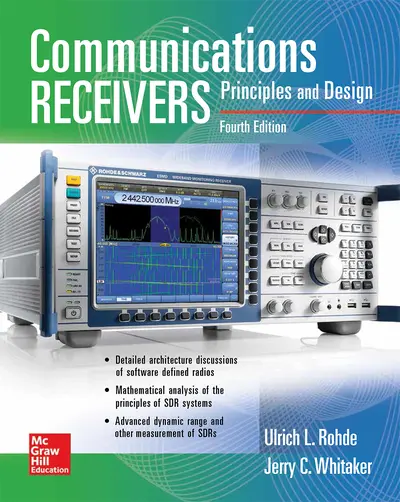My Account Details

ISBN10: 0071843345 | ISBN13: 9780071843348

Step 1 . Download Adobe Digital Editions to your PC or Mac desktop/laptop.
Step 2. Register and authorize your Adobe ID (optional). To access your eBook on multiple devices, first create an Adobe ID at account.adobe.com. Then, open Adobe Digital Editions, go to the Help menu, and select "Authorize Computer" to link your Adobe ID.
Step 3. Open Your eBook. Use Adobe Digital Editions to open the file. If the eBook doesn’t open, contact customer service for assistance.
State-of-the-art communications receiver technologies and design strategies
This thoroughly updated guide offers comprehensive explanations of the science behind today’s radio receivers along with practical guidance on designing, constructing, and maintaining real-world communications systems. You will explore system planning, antennas and antenna coupling, amplifiers and gain control, filters, mixers, demodulation, digital communication, and the latest software defined radio (SDR) technology. Written by a team of telecommunication experts, Communications Receivers: Principles and Design, Fourth Edition, features technical illustrations, schematic diagrams, and detailed examples.
Coverage includes:
• Basic radio considerations
• Radio receiver characteristics
• Receiver system planning
• Receiver implementation considerations
• RF and baseband techniques for Software-Defined Radios
• Transceiver SDR considerations
• Antennas and antenna coupling
• Mixers
• Frequency sources and control
• Ancillary receiver circuits
• Performance measurement
1.1 Introduction
1.1.1 SDR, Defined
1.2 Radio System Frontiers
1.2.1 5G Fundamentals
1.2.2 Looking Ahead
1.3 Radio Communications Systems
1.3.1 Radio Transmission and Noise
1.4 Modulation
1.4.1 Analog Modulation
1.4.2 Modulation for Digital Signals
1.5 Digital Signal Processing
1.5.1 Analog-to-Digital (A/D) Conversion
1.5.2 Digital-to-Analog (D/A) Conversion
1.5.3 Converter Performance Criteria
1.5.4 Processing Signal Sequences
1.5.5 Digital Filters
1.5.6 Nonlinear Processes
1.5.7 Decimation and Interpolation
1.5.8 DSP Hardware and Development Tools
1.6 Radio Receiver Architectures
1.6.1 Super-Regenerative Receivers
1.7 Typical Radio Receivers
1.7.1 Analog Receiver Design
1.7.2 Mixed-Mode MFSK Communication System
1.7.3 PLL CAD Simulation
1.7.4 Software-Defined Radio Systems
1.7.5 Design Example: EB 500 Monitoring Receiver
1.8 References
1.9 Bibliography
1.10 Suggested Additional Reading
2 Radio Receiver Characteristics
2.1 Introduction
2.2 The Radio Channel
2.2.1 Channel Impulse Response
2.2.2 Doppler Effect
2.2.3 Transfer Function
2.2.4 Time Response of Channel Impulse Response and Transfer Function
2.3 Radio System Implementation
2.3.1 Input Characteristics
2.3.2 Gain, Sensitivity, and Noise Figure
2.4 Selectivity
2.5 Dynamic Range
2.5.1 Desensitization
2.5.2 AM Cross Modulation
2.5.3 IM
2.6 Reciprocal Mixing
2.6.1 Phase Errors
2.6.2 Error Vector Magnitude
2.7 Spurious Outputs
2.8 Gain Control
2.9 BFO
2.10 Output Characteristics
2.10.1 Baseband Response and Noise
2.10.2 Harmonic Distortion
2.10.3 IM Distortion
2.10.4 Transient Response
2.11 Frequency Accuracy and Stability
2.12 Frequency Settling Time
2.13 Electromagnetic Interference
2.14 Digital Receiver Characteristics
2.14.1 BER Testing
2.14.2 Transmission and Reception Quality
2.15 References
2.16 Bibliography
2.17 Suggested Additional Reading
3 Receiver System Planning
3.1 The Receiver Level Plan
3.2 Calculation of NF
3.2.1 Noise Factor for Cascaded Circuits
3.3 Noise Correlation in Linear Two Ports Using Correlation Matrices
3.3.1 Noise Figure Test Equipment
3.3.2 How to Determine the Noise Parameters
3.4 Linearity
3.4.1 Dynamic Range, Compression, and IMO
3.4.2 Analysis
3.5 Calculation of IP
3.5.1 Example of NF and IP Calculation
3.6 Spurious Response Locations
3.6.1 D-H Traces
3.7 Selectivity
3.7.1 Single-Tuned Circuit
3.7.2 Coupled Resonant Pairs
3.8 Complex Filter Characteristics
3.8.1 Butterworth Selectivity
3.8.2 Chebyshev Selectivity
3.8.3 Thompson or Bessel Selectivity
3.8.4 Equiripple Linear Phase
3.8.5 Transitional Filters
3.8.6 Elliptic Filters
3.8.7 Special Designs and Phase Equalization
3.9 Filter Design Implementation
3.9.1 LC Filters
3.9.2 Electrical Resonators
3.9.3 Electromechanical Filters
3.9.4 Quartz Crystal Resonators
3.9.5 Monolithic Crystal Filters
3.9.6 Ceramic Filters
3.10 Time-Sampled Filters
3.10.1 Discrete Fourier and z Transforms
3.10.2 Discrete-Time-Sampled Filters
3.10.3 Analog-Sampled Filter Implementations
3.11 Digital Processing Filters
3.12 Frequency Tracking
3.13 IF and Image Frequency Rejection
3.14 Electronically Tuned Filter
3.14.1 Diode Performance
3.14.2 A VHF Example
3.15 References
3.16 Suggested Additional Reading
4 Receiver Implementation Considerations
4.1 Introduction
4.2 Digital Implementation of Receiver Functions
4.2.1 Digital Receiver Design Techniques
4.2.2 Noise Calculations
4.2.3 Noise Cancellation
4.2.4 Spectral Subtraction
4.3 Spread Spectrum
4.3.1 Basic Principles
4.3.2 Frequency Hopping
4.3.3 Direct Sequence
Need support? We're here to help - Get real-world support and resources every step of the way.